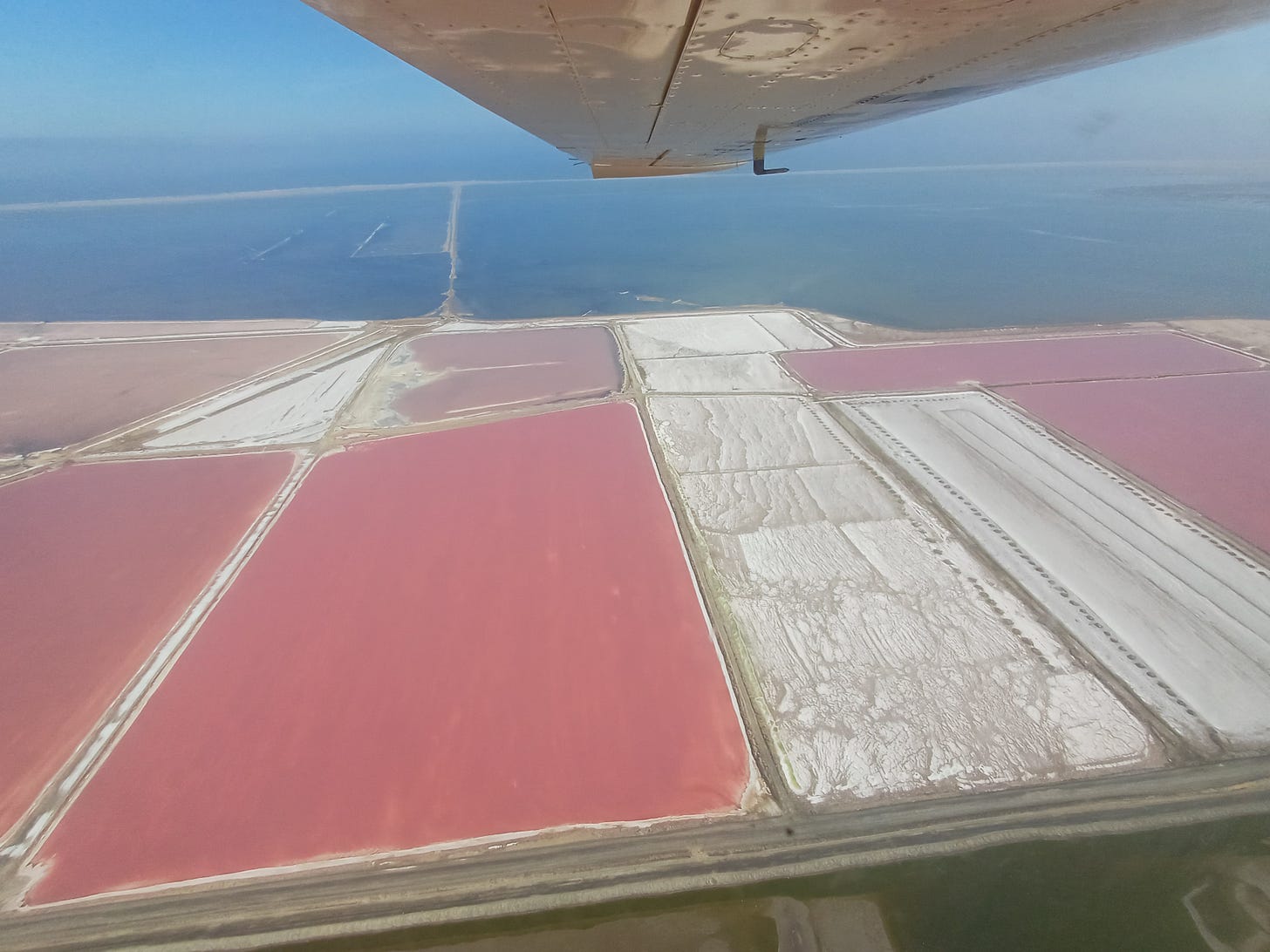It was March 2024 when I joined Henk, as pilot and guide, on a three-night, five-day trip with Skeleton Coast Safaris in Namibia1. It's a flying safari, an experience of a lifetime - I won't forget this trip in a hurry. [You may want to read the following, related posts as well: Night Two and Night Three]
Two further tourists joined us at Eros airport in Windhoek, where we boarded a small Cessna four-seater to fly to Swakopmund via the Khomas Hoogland, the Sossusvlei dunes and the Atlantic coast. Our altitude is quite low, we can see the cattle and goats on the farms below, with Henk keeping us updated on our surroundings and Namibia in general. For example, in Namibia, cattle farmers work on a requirement of 50 hectares per cattle, and I think it was 20 or 30 hectares per goat. In the distance, I can see Spreetshoogte Pass, I had driven it a few weeks prior.
Along the coast, we fly over shipwrecks, abandoned diamond mines, salts pans, and past Walvis Bay. The picture below shows evaporation pans, near Walvis Bay, that are used in the production of sea salt; the pink colour is due to halophilic bacteria that contain carotenoid pigments.2
We landed at Swakopmund airport to refuel before heading north along the coast. The cold Benguela current, which originates near the Antarctic, is rich in oxygen and plankton that attract large schools of fish, which makes this coastline popular with rock anglers and hosts thousands upon thousands of seals. Apparently, this marine ecosystem may be declared a UNESCO World Heritage Site3.
We bank right to head inland, landing in the Ugab formations. The navigational and flying skills of Henk are amazing; I'd have trouble finding these remote landing strips.
After landing in the Ugab formations, a lesson in the local geology, including the “elephant skin” rock formations, and plants such as the Welwitschia, which is actually a tree; the oldest Welwitschia in Namibia is 3,600 years old.
A short flight to the Quidas camp, where we will spend the night. Jannson and his wonderful team, Bernard, Ngeni, Veronese and Janelie, spoil us with their company, happy demeanour and lekker food when we get to the camp, and the following morning with coffee at our tents and a hot bucket shower. Before going to sleep and after waking up, I peruse the vlakte [valley] in front of the camp. This landscape is something different and it's a real privilege being here.
I like catching up with the camp crews. I've been here before, having travelled by 4x4 a few years ago. In my Namibian travels, I've learned that many people have a “school name” and a “home name”. There are 12 different ethnic groups in Namibia and, so I'm told, they have difficulty pronouncing each other’s names correctly; thus, many have a “school name”. The “home names” often have a particular significance; at Quidas camp, they are:
Uerihuhua: She talked to dead people
Nokokure kunouoye: If you go far, you will see people
Mbakaera: He’s a bit too short
Uapiza: The people moved away
The next morning, I woke up early and had a chat with Bernard and Jansson before going for a solo sunrise walk. After breakfast, we went for a walk with Henk in the koppies (hills) behind the Quidas camp. There are San (Bushman) paintings here and archaeological evidence of San tools and materials here, some of it brought from the Atlantic coast. The San paintings are explained to us by Henk, as is their colour palette. Amongst the rocks, some paintings show evidence of damage. The San “killed” the spirits of previous inhabitants, but not animals. A white colour was used to indicate foreigners or unknowns. One of the paintings shows people dancing and donkeys, both unknowns; were these trekkers from the south? 4
Hieroglyphs can be dated between 500 and 25,000 years old, depending on the oxidation status of the engraving. A buffalo track is estimated at 1,000 years old. Was there enough water then to sustain these animals? One rock has engravings of human feet and toes, which indicates the presence of a water spring nearby.
After returning to camp and refreshments, we drive to the “organ pipe” geological formations. Along the way, we see rhino tracks, probably one to two days old, Henk tells us. There are underground rivers in this region that feed springs. The black rhino can eat all plants that grow in the Ugab valley. We also see ostrich and oryx. The desert is definitely not dead!
At 3 p.m., we fly out of Quidas heading towards Terrace Bay, our next camp is at Leylandsdrift.
Skeleton Coast Safaris | Fly-in Safari Namibia [https://www.skeletoncoastsafaris.com]
The pink colour of lakes, with an example from Australia. James T. Teller. https://doi.org/10.1016/S0140-1963(18)31179-0
Fun facts about the Benguela Current in Namibia [https://gondwana-collection.com/blog/fun-facts-about-the-benguela-current-in-namibia]
San | Indigenous Hunter-Gatherers of Southern Africa | Britannica













